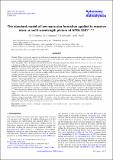Files in this item
The standard model of low-mass star formation applied to massive stars : a multi-wavelength picture of AFGL 2591
Item metadata
| dc.contributor.author | Johnston, K.G. | |
| dc.contributor.author | Shepherd, D.S. | |
| dc.contributor.author | Robitaille, T.P. | |
| dc.contributor.author | Wood, K. | |
| dc.date.accessioned | 2014-09-23T13:31:02Z | |
| dc.date.available | 2014-09-23T13:31:02Z | |
| dc.date.issued | 2013-03 | |
| dc.identifier | 150593870 | |
| dc.identifier | d6007751-4d13-4d8c-91f6-51263ab287b9 | |
| dc.identifier | 84874062217 | |
| dc.identifier.citation | Johnston , K G , Shepherd , D S , Robitaille , T P & Wood , K 2013 , ' The standard model of low-mass star formation applied to massive stars : a multi-wavelength picture of AFGL 2591 ' , Astronomy & Astrophysics , vol. 551 , A43 . https://doi.org/10.1051/0004-6361/201219657 | en |
| dc.identifier.issn | 0004-6361 | |
| dc.identifier.uri | https://hdl.handle.net/10023/5480 | |
| dc.description.abstract | Context. While it is currently unclear from a theoretical standpoint which forces and processes dominate the formation of high-mass stars, and hence determine the mode in which they form, much of the recent observational evidence suggests that massive stars are born in a similar manner to their low-mass counterparts. Aims. This paper aims to investigate the hypothesis that the embedded luminous star AFGL 2591-VLA 3 (2.3 × 105 L⊙ at 3.33 kpc) is forming according to a scaled-up version of a low-mass star formation scenario. Methods. We present multi-configuration Very Large Array (VLA) 3.6 cm and 7 mm, as well as Combined Array for Research in Millimeter Astronomy C18O and 3 mm continuum observations to investigate the morphology and kinematics of the ionized gas, dust, and molecular gas around AFGL 2591. We also compare our results to ancillary Gemini North near-IR images, and model the near-IR to sub-mm spectral energy distribution (SED) and Two Micron All Sky Survey (2MASS) image profiles of AFGL 2591 using a Monte-Carlo dust continuum radiative transfer code. Results. The observed 3.6 cm images uncover for the first time that the central powering source AFGL 2591-VLA 3 has a compact core plus collimated jet morphology, extending 4000 AU eastward from the central source with an opening angle of <10° at this radius. However, at 7 mm VLA 3 does not show a jet morphology, but instead compact (<500 AU) emission, some of which (<0.57 mJy of 2.9 mJy) is estimated to be from dust emission. The spectral index of AFGL 2591-VLA 3 between 3.6 cm and 7 mm was found to be between 0.4 and 0.5, similar to that of an ionized wind. If the 3.6 cm emission is modelled as an ionized jet, the jet has almost enough momentum to drive the larger-scale flow. However, assuming a shock efficiency of 10%, the momentum rate of the jet is not sufficient to ionize itself via only shocks, and thus a significant portion of the emission is instead likely created in a photoionized wind. The C18O emission uncovers dense entrained material in the outflow(s) from these young stars. The main features of the SED and 2MASS images of AFGL 2591-VLA 3 are also reproduced by our model dust geometry of a rotationally flattened envelope with and without a disk. Conclusions. The above results are consistent with a picture of massive star formation similar to that seen for low-mass protostars. However, within its envelope, AFGL 2591-VLA 3 contains at least four other young stars, constituting a small cluster. Therefore it appears that AFGL 2591-VLA 3 may be able to source its accreting material from a shared gas reservoir while still exhibiting the phenomena expected during the formation of low-mass stars. | |
| dc.format.extent | 23 | |
| dc.format.extent | 2870269 | |
| dc.language.iso | eng | |
| dc.relation.ispartof | Astronomy & Astrophysics | en |
| dc.subject | Radiative transfer | en |
| dc.subject | Techniques: interferometric | en |
| dc.subject | Circumstellar matter | en |
| dc.subject | Stars: formation | en |
| dc.subject | Stars: massive | en |
| dc.subject | ISM: jets and outflows | en |
| dc.subject | QB Astronomy | en |
| dc.subject | QC Physics | en |
| dc.subject.lcc | QB | en |
| dc.subject.lcc | QC | en |
| dc.title | The standard model of low-mass star formation applied to massive stars : a multi-wavelength picture of AFGL 2591 | en |
| dc.type | Journal article | en |
| dc.contributor.sponsor | Science & Technology Facilities Council | en |
| dc.contributor.institution | University of St Andrews. School of Physics and Astronomy | en |
| dc.identifier.doi | 10.1051/0004-6361/201219657 | |
| dc.description.status | Peer reviewed | en |
| dc.identifier.url | http://www.aanda.org/articles/aa/olm/2013/03/aa19657-12/aa19657-12.html | en |
| dc.identifier.grantnumber | ST/J001651/1 | en |
This item appears in the following Collection(s)
Items in the St Andrews Research Repository are protected by copyright, with all rights reserved, unless otherwise indicated.

